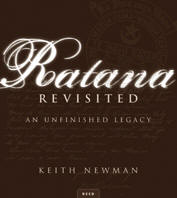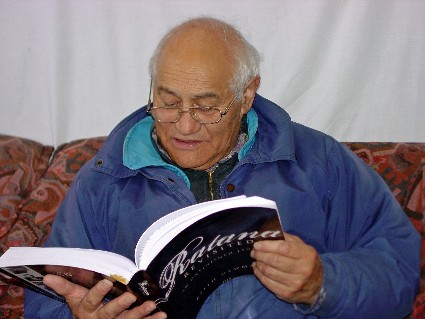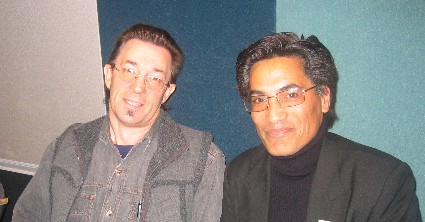|
Having my book Ratana Revisited published by Reed in July 2006 was a great honour and privilege and - once the dust of dissension dies down - I believe the Ratana church and movement can only become stronger with this great legacy now finally in the public domain. According to the 2006 official census figures the Ratana Church is in the midst of the strongest growth period ever, with an increase of 5388 over the 2001 period with 50,565 currently claiming membership. There’s also evidence however that many who previously claimed Ratana allegiance have defected to Destiny and other Christian churches so the true number who have historic loyalty remains unknown. When joined with those who adhere to Ratana for political guidance the numbers could be considerably greater.
What’s missing from
Ratana today is a clear mission statement.
Ratana Revisited
was my honest attempt to bring together the disparate information about
T. W. Ratana and the movement he founded, and how it operated in the
past through to its current role. The book was inspired by the desires
of a ‘new generation’ of Ratana who are hungry to have easier access to
their own heritage. The Ratana movement president and its central church committee, Komiti Haahi Matua, saw fit to publish a paid advertisement in many of the country’s main newspapers in November 2006, clarifying what the book already makes clear, that its publication was not officially sanctioned or approved of by the movement hierarchy. It was never, as some critics have suggested, intended to be a biography, for that would have focused more on the man than the movement; and it was never intended to represent itself as an official Ratana book. For that to have happened it would have required the support of the central church committee, the president and the core family members who themselves have difficulty agreeing on the official line. You cannot write a book by committee, nor can an independent endeavor such as this benefit by having people with vested interests have any level of control over your manuscript. Despite ongoing conversations with the movement president and encouragement and guidance from its legal advisor; even allowing him a copy of my draft document, there was a refusal to make specific corrections or comments. The only advice given by the movement’s legal advisor was ‘do a scholarly job, get your sources right and the book will stand on its own’. Official help with research was sought but denied on several occasions over the 20-year period of research. Officials and senior people within the movement have however given their support in various ways and there is growing support from a core of key people, even those who originally opposed the publication but now see my intentions were honourable.
Toward the end of
the publishing cycle however there were demands to see a finished
manuscript. Despite considerable pressure to comply with this request I
declined, largely because too many people now knew about the impending
book and some of them appeared intent on preventing it from being
published. For the final stages of the book I opted to only work with an
inner core, including Uri Whakatupuranga members and Whetu Tiritakene-Sullivan. Even in the last days before the book went to the printer there were threats made to prevent publication. I admire Reed publishing for their strong support of me through this period. I have always clearly stated there was no official support for the book, including in the preface itself.
The launch itself
was not without incident. It was intended to launch the book at Orakei
Marae, overlooking the Michael Joseph Savage Memorial. The venue was
booked and those attending the church service at the Ratana church on
the foreshore below were to have traveled along with guests up to the
marae but the day before someone with connections to Orakei had died and
commandeered the facilities. While the TV crews unfortunately still went to Orakei, the event at Waipapa was still a stunning and historical gathering. Elders from Ratana parishes across the country arrived, many of whom had not talked together or been in the same room for many years. It was a healing time. I was ushered onto the marae by members of the Paikea family, the family who were in many ways responsible for my continuing interest in the Ratana legacy. About 200 people attended, with guests on both sides having a say. Kereama Pene was MC, presenting over a dozen books to dignitaries and guests. Both Ruia Aperahama and Whetu Tirikatene-Sullivan gave stirring speeches. Unfortunately plans for attendance by tumuaki Harerangi Meihana and a number of senior Ratana people from the lower North Island were undermined when one apostle, who opposed the book despite refusing to read it, called a meeting at Ratana Pa. While we were celebrating the release they were discussing the reasons why it should never have been published. The first of my two part radio documentary Ratana Revisited played on National Radio just as the launch was concluding. Copies of the programme were mailed out to key church members and those who had participated in the book, including Whetu, Ratana’s original biographer Jim McLeod Henderson and Harerangi Meihana who were all interviewed for the documentary. There were also lively interviews with myself about the book on National Radio, Radio Waatea, Radio Te Hiku in Northland, Radio Rhema, Radio Pacific and Radio Live. Whetu Tirikatene-Sullivan says the book lays down a wero (challenge) to Ratana morehu and Maori in general. She admits it may have been preferable that a Ratana morehu had written it but having read it twice found little to contest. “If I was in hospital I would prefer to know that the surgeon was full qualified before he began the task and if I fly in an aeroplane I like to be confident the pilot knows how to fly the plane,” she told an interviewer on Radio Waatea.
In the meantime some
of those who had been opposed to the book, having read it through,
admitted they had over-reacted. One outspoken critic in particular went
on to buy 14 copies for her relatives. On one particular radio interview
a senior Ratana minister phoned in and, according to those who
understood te reo, used language against the author and the book, the
like of which had never been heard before on Maori radio.
They have met with a
group of Japanese Catholic bishops who were in the country for a brief
time who gave them a biography of T. W. Ratana’s long time friend Bishop
Juji Nakada and they in turn gave the bishops a copy of Ratana
Revisited. A contrary approach however was taken in the Listener (Oct 21-27, 2006) issue, under the heading Men of God, in the ‘culture’ section. Mike Grimshaw, a self described ‘dissenting, non-practising Presbyterian – perhaps a type of secular theologian’, and allegedly one of the country’s top academic theological authorities, delivers scathing comments about Ratana Revisited and its writer. Sandwiched between his review of an autobiography by the former Presbyterian theologian now ‘Christian Buddhist’ Lloyd Geering, and a book on 1920s Auckland Catholic bishop James Michael Liston, Grimshaw states Ratana Revisited is a perfect example of how not to write a biography. He says it is incredulous and marred by Pentecostal Christian proselytizing, faith statements and uncritiqued endorsements of Ratana that align him with televangelists like Derek Prince, Benny Hinn and Brian Tamaki. ‘Because Newman sees Ratana as “pointing us to a divine plan unfolding”, this work needs to be read despite what the biographer says. Yet it is also a reminder of how the Labour Party linked itself to a sectarian prophetic movement that, considered from today’s viewpoint, would almost automatically consign it to the fringes of acceptability.’ Grimshaw goes on about the book’s desperate need of editing; ‘it is over 500 pages (very) long, a “kitchen sink and all” compendium of all that Newman considers important. The layout is deeply problematic with the narrative interrupted by a series of intrusive sections. It is a prime example of how not to write a biography of a historically important religious figure.’ There is very little about the book itself in the so-called review which mis-labels my work as a biography. It has much broader brief in that it places the entire movement within the context of the past and present and attempts an analysis of where it stands spiritually, politically and socially, and the challenges faced as it moves into the future. His first hint at his attitude toward the author and the book is in his labeling me ‘a Pentecostal-inclined, non-conformist, evangelical seeker’ which is not far from the truth but his early dig at my father, a former Anglican minister ‘who encountered difficulties for his belief in faith healing and miracles’, seemed unwarranted. He used this leverage to somehow explain the bias he claims to have found in my writing. I made no secret of my back stating in the preface:
I will leave readers to decide for themselves how to view my research, my writing style and my conclusions which I make no apologies for. In fact it is the my understanding, that since the release of Ratana Revisited there has been more positive and open discussion among former and current Ratana members about the origins and destiny of their movement than there has been for many years. As a result a number of important documents have been handed over to the Uri Whakatupuranga group for translation and archival, and many people who haven’t spoken for a long time are now in regular contact - Keith Newman 12-12-06
|

 Ratana
Revisited - an unfinished legacy,
Ratana
Revisited - an unfinished legacy,


